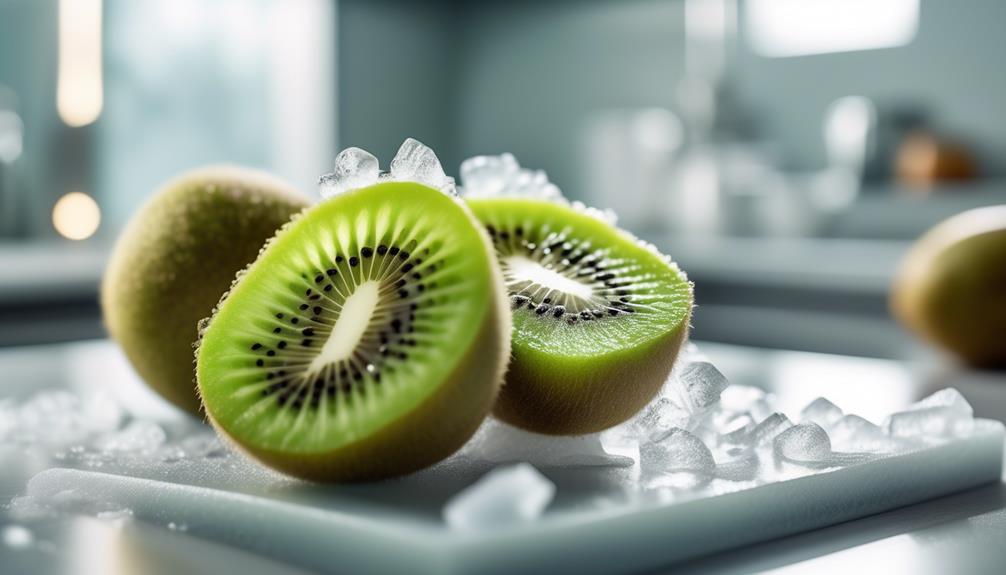Just as a squirrel stores nuts for the winter, you too can preserve the sweet tang of summer by freezing kiwi for use throughout the year. You'll want to select firm, ripe kiwis, ensuring they're neither too hard nor too mushy, to begin the process.
First, you'll wash the fruit thoroughly, then peel off the fuzzy outer layer which isn't as pleasant to eat once frozen. When it comes to slicing, you have options: rounds, halves, or chunks depending on your future use.
But here's where you might pause—the next steps are crucial to maintaining the fruit's vibrant color and fresh taste. Discover how blanching can be an invaluable step in the freezing process, and why packing your kiwi properly can make all the difference when it comes time to enjoy them later.
Key Takeaways
- Select firm, ripe kiwis without blemishes or bruises.
- Wash and peel the kiwis carefully before freezing.
- Use the blanching technique to maintain color and texture.
- Pack and store frozen kiwi in airtight containers or bags to prevent freezer burn.
Selecting the Right Kiwis
To ensure your kiwis freeze well, always choose firm, ripe fruits that yield slightly under gentle pressure. Kiwi ripeness is crucial; too soft and they'll be mushy when thawed, too hard and they won't have that sweet tanginess you're after. You're looking for that sweet spot where the kiwi is just ripe enough to eat fresh.
Keep in mind the variety differences when selecting your kiwis. The most common variety, the Hayward, is larger and has a longer shelf life, which can affect its freezing properties. Other varieties, like the gold kiwi, have a thinner skin and a more tropical flavor. They may freeze differently due to their unique texture and moisture content.
Check the skin for blemishes or bruises, which can also impact the freezing process. The ideal kiwi has unblemished skin and a pleasant, fragrant scent. If you're unsure about the ripeness, give the kiwi a sniff – a ripe kiwi will have a sweet and slightly tangy aroma.
Preparing Your Kiwi
Before freezing your selected kiwis, wash and peel them carefully to remove any dirt or pesticides and ensure a smooth texture upon thawing. Kiwi ripeness is crucial; too ripe, and they'll be mushy when thawed, too firm and they mightn't have the full sweet-tart flavor you're looking for.
Peeling tips:
- Use a paring knife or a vegetable peeler for control and to minimize waste.
- Slice off both ends of the kiwi to create a stable base.
- Gently run your peeler or knife just under the skin, turning the kiwi as you go.
When peeling, remember:
- The skin should come off easily if the kiwi is ripe.
- Peel gently to keep as much of the fruit intact as possible.
Now, let's break down the steps:
- Washing:
- Rinse under cold water.
- Gently rub the surface.
- Pat dry with a clean towel.
- Peeling:
- Cut off the ends.
- Slide your peeler or knife under the skin.
- Rotate and repeat until fully peeled.
Blanching Technique Explained
Understanding the blanching technique can ensure that your kiwis retain their vibrant color and optimal texture after freezing. Blanching, a quick cook in boiling water followed by an immediate plunge into ice water, halts the enzymes that lead to spoilage and loss of kiwi nutrition. It's a critical step to maintain the fruit's desirable qualities.
To blanch your kiwis, first peel and slice them. Boil water in a large pot, and have a bowl of ice water ready. Submerge the kiwi slices in the boiling water for about 30 seconds to a minute. Quickly remove them with a slotted spoon and transfer to the ice water. This shock stops the cooking process, preserving the kiwi's firmness and nutrients.
If you're looking for blanching alternatives, consider using ascorbic acid or a fruit preserver which can help protect the kiwi's color and nutritional value. Simply sprinkle the preserver over the sliced kiwi according to the package instructions before freezing.
Packing and Storing
Once your kiwi slices are blanched and cooled, you'll need to pack them properly for storage to maintain their freshness. The right kiwi containers and labeling tips are key to ensuring your fruit remains tasty and identifiable in the freezer.
- Choose the Right Containers
- Airtight plastic bags or containers: These prevent freezer burn and preserve the kiwi's texture.
- Glass jars with tight lids: Suitable for those who prefer plastic-free options.
Labeling Tips
- Use freezer tape and a permanent marker to label each container with the date and contents.
- Include the quantity or weight if you'll need specific portions later.
Make sure there's minimal air in the bags or containers before sealing them. This helps to prevent ice crystals from forming on your kiwi slices. If using bags, lay them flat in the freezer initially until the kiwi is frozen solid; this allows for easier stacking and saves space. In containers, leave a small headspace to allow for expansion.
Thawing and Using Frozen Kiwi
To enjoy your frozen kiwi at its best, thaw it in the refrigerator overnight or at room temperature for a few hours. Thawing slowly in the fridge helps maintain the fruit's texture and flavor. If you're short on time, leaving it out at room temperature speeds up the process, but be sure to use it as soon as it's soft to avoid over-thawing.
Once your kiwi is thawed, it's a versatile ingredient for a variety of dishes. Toss it into a blender for a refreshing kiwi smoothie, combining it with other fruits, yogurt, or juice for a nutritious drink. Frozen kiwi actually works better for smoothies, as it lends a creamy texture and a cold temperature without the need for added ice.
If smoothies aren't your thing, consider making a fruit compote. Gently heat your kiwi with a touch of sugar and maybe a splash of lemon juice, until the fruit breaks down into a sauce. This compote can be a delightful topping for pancakes, ice cream, or yogurt. Remember, frozen kiwi is softer than fresh, so it's perfect for recipes where the fruit is meant to be mashed or blended.

